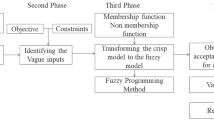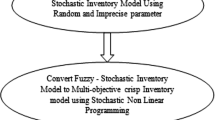Abstract
We consider here the inventory problems with infinite rate of replenishment in crisp and fuzzy environments over a finite time horizon for deteriorating multi-items taking time dependent demand and allowing shortages and equal replenishment cycles. Here, the objectives of maximizing the profit and minimizing the replenishment cost are imprecise in nature. Total shortage cost is assumed to be limited but vague and imprecise in non-stochastic sense. The impreciseness in the above objectives’ and constraint’ goals have been expressed by fuzzy linear Membership Functions (MFs). Under these assumptions, a Decision Maker (DM) is confronted with four possibilities depending upon the nature of the first and last cycles and he/she has to choose the best one for maximum profit-ratio (i.e. the ratio of total profit to total cost). Hence, both crisp and fuzzy models with different shortage criteria are developed and solved by the weighted fuzzy non-linear programming (WFNLP) and goal attainment methods (GAM). Fuzzy models have also been solved by an integrated goal attainment and fuzzy non-linear programming technique (GAFNLP). Models are illustrated with numerical examples and the results are compared.
Similar content being viewed by others
References
Wagner, H. M., Whitin, T. M. (1958), Dynamic version of the economic lot size model, Management Science, 5, 89–96.
Silver, E. A. and Meal, H. C. (1973), A huristic for selecting lot size quantities for the case of a deterministic time varying demand rate and discrete opportunities for replenishment, Production Inventory Management, 14, 64–74.
Donaldson, W. A. (1991), Inventory replenishment policy for a linear trend in demand — an analytical solution, Operational Research Quarterly, 28, 663–670.
Teng, J. T., Chem, M. S. and Yang, H. L. (1997), An Optimal Recursive Method for Various Inventory Replenishment Models with Increasing Demand and Shortages, Naval Research Logistics, 44, 791–806.
Dave, U. and Patel, L. K. (1981), (T, S i ) policy inventory model for deteriorating items with time proportional demand, Journal of Operational Research Society, 32, 137–142.
Kang, S. and Kim, A. (1983), A study on the price and production level of the deteriorating inventory system, International Journal of Production Research, 21, 899–908.
Sachan, R. S. (1991), (T, S i ) Inventory policy model for deteriorating items with time proportional demand, Journal of Operational Research Society, 35, 1013–1019.
Goswami, A. and Chaudhuri, K. S. (1991), An EOQ model for deteriorating items with shortages and a linear trend in demand, Journal of Operational Research Society, 42, 1105–1110.
Bhunia, A.K. and Maiti, M. (1994), A Two Warehouse Inventory Model for a Linear Trend in Demand, OPSEARCH, 31(4), 318–329.
Hariga, M. (1995), An EOQ model for deteriorating items with shortages and time-varying demand, Journal of Operational Research Society, 46, 398–404.
Hariga, M. A. and Benkherouf, L. (1994), Optimal and heuristic inventory replenishment models for deteriorating items with exponential time-varying demand, European Journal of Operational Research, 79, 123–137.
Chakrabarti, T. and Chaudhuri, K. S. (1997), An EOQ model for deteriorating items with a linear trend in demand and shortages, International Journal of Production Economics, 49, 205–213.
Bhunia, A.K. and Maiti, M. (1997), A Deterministic Inventory Replenishment Problem for Deteriorating Items with Time-Dependent Demand and Shortages for the finite Time Horizon, OPSEARCH, 34, 51–61.
Chang, H. J. and Dye, C. Y. (1999), An EOQ model for deteriorating items with time varying demand and partial backlogging, Journal of Operational Research Society, 50, 1176–1182.
Bellman, R. E. and Zadeh, L. A. (1970), Decision making in a fuzzy environment, Management Sceince, 17(4), B141–B164.
Tanaka, H., Okuda, T. and Asai, K. (1974), On fuzzy mathematical programming, Journal of Cybernetics, 3(4), 37–46.
Zimmermann, H. J. (1976), Description and optimization of fuzzy systems, International Journal of General Systems, 2(4), 209–215.
Roy, T. and Maiti, M. (1998), Multi-objective inventory models of deteriorating items with some constraints in a fuzzy environment, Computers and Operations Research, 25, 1085–1095.
Zimmermann, H. J. (1978), Fuzzy linear programming with several objective functions, Fuzzy Sets and Systems, 1, 46–55.
Author information
Authors and Affiliations
Rights and permissions
About this article
Cite this article
Das, K., Roy, T.K. & Maiti, M. Multi-Objective Fuzzy Inventory Model For Deteriorating Items With Shortages Over A Finite Time Horizon. OPSEARCH 40, 252–277 (2003). https://doi.org/10.1007/BF03398699
Published:
Issue Date:
DOI: https://doi.org/10.1007/BF03398699




